高考英语(江西专用)一轮复习语法专项:介词与介词短语
- 格式:doc
- 大小:82.13 KB
- 文档页数:9
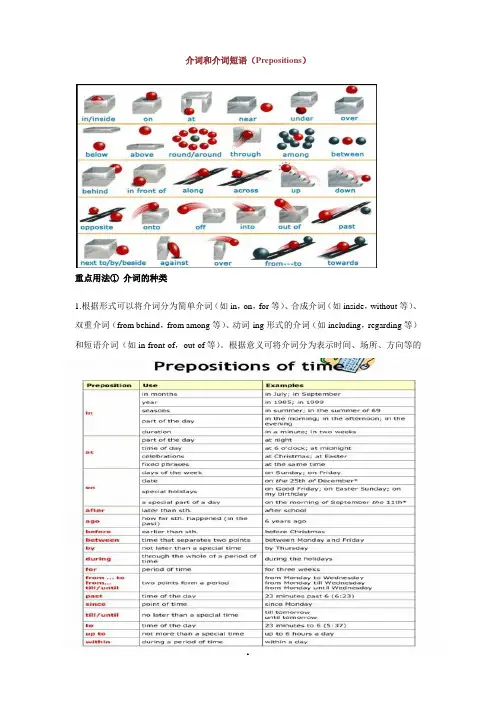
介词和介词短语(Prepositions)重点用法①介词的种类1.根据形式可以将介词分为简单介词(如in,on,for等)、合成介词(如inside,without等)、双重介词(from behind,from among等)、动词-ing形式的介词(如including,regarding等)和短语介词(如in front of,out of等)。
根据意义可将介词分为表示时间、场所、方向等的介词,介词在句中不能独立做成分。
2.表示时间的介词after在……之后before在……之前around大约……at在……时by到……为止in在……后on在……时till/until直到……3.表示场所、方向的介词across在……对面along沿着……at在……in在……里on在……上above在……上方under/below在……下面beside在……旁边behind在……后面before/in front of在……前面between在……之间among在……之间4.其他介词about关于;对于from从;自从with与……一起;用of……的;属于……的to向;到;对as担任;像;作为for对于;为了;给……besides除了……还有重点用法②表示时间的常用介词辨析用法:1.at表示时刻、时间的某一点;on表示具体的某一天,某一天的上、下午;in表示月、季节、年,泛指上午、下午、晚上(在一段时间内)。
at lunch在午餐时on Monday在周一in January在一月2.before表示“在……之前”;after表示“在……之后”。
I will be back before lunch.午饭之前我赶回来。
The nights start after half past five in winter.冬天的夜晚在5点半之后开始。
3.by表示“在……之前,截止到……”;until/till表示“直到……为止”;by表示到什么时候为止动作已经完成,而until表示动作持续到什么时候,在终止性动词的否定式中,二者通用。
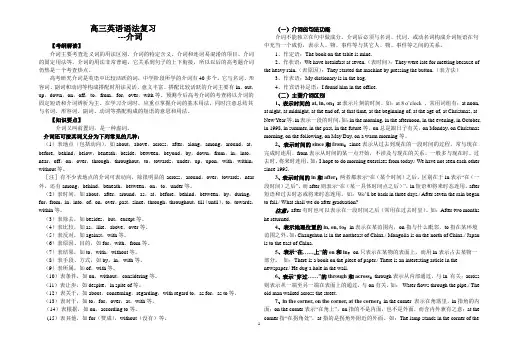
高三英语语法复习---介词【考纲解读】介词主要考查近义词的用法区别、介词的特定含义、介词和连词易混淆的项目、介词的固定用法等。
介词的用法非常普遍,它关系到句子的上下衔接,所以以后的高考题介词仍然是一个考查热点。
高考研究介词是英语中比较活跃的词,中学阶段所学的介词有40多个。
它与名词、形容词、副词和动词等构成搭配时用法灵活,意义丰富。
搭配比较活跃的介词主要有in,out,up,down,on,off,to,from,for,over,with等。
预测今后高考介词的考查将以介词的固定短语和介词辨析为主。
在学习介词时,应重点掌握介词的基本用法,同时注意总结其与名词、形容词、副词、动词等搭配构成的短语的意思和用法。
【知识要点】介词又叫前置词,是一种虚词。
介词还可按其词义分为下列常见的几种:(1)表地点(包括动向),如about,above,across,after,along,among,around,at,before,behind,below,beneath,beside,between,beyond,by,down,from,in,into,near,off,on,over,through,throughout,to,towards,under,up,upon,with,within,without 等。
[注]有不少表地点的介词可表动向,除很明显的across,around,over,towards,near 外,还有among,behind,beneath,between,on,to,under等。
(2)表时间,如about,after,around,as,at,before,behind,between,by,during,for,from,in,into,of,on,over,past,since,through,throughout,till(until),to,towards,within等。


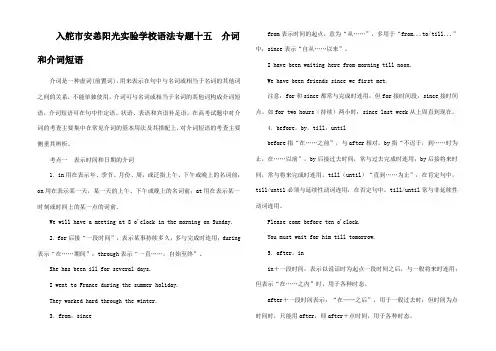
入舵市安恙阳光实验学校语法专题十五介词和介词短语介词是一种虚词(前置词),用来表示在句中与名词或相当于名词的其他词之间的关系,不能单独使用。
介词可与名词或相当于名词的其他词构成介词短语,介词短语可在句中作定语、状语、表语和宾语补足语。
在高考试题中对介词的考查主要集中在常见介词的基本用法及其搭配上,对介词短语的考查主要侧重其辨析。
考点一表示时间和日期的介词1.in用在表示年、季节、月份、周,或泛指上午、下午或晚上的名词前;on用在表示某一天,某一天的上午、下午或晚上的名词前;at用在表示某一时刻或时间上的某一点的词前。
We will have a meeting at 8 o'clock in the morning on Sunday.2.for后接“一段时间”,表示某事持续多久,多与完成时连用;during 表示“在……期间”;through表示“一直……,自始至终”。
She has been ill for several days.I went to France during the summer holiday.They worked hard through the winter.3.from,sincefrom表示时间的起点,意为“从……”,多用于“from...to/till...”中;since表示“自从……以来”。
I have been waiting here from morning till noon.We have been friends since we first met.注意:for和since都常与完成时连用,但for接时间段,since接时间点。
如for two hours(持续)两小时;since last week从上周直到现在。
4.before,by,till,untilbefore指“在……之前”,与after相对。
by指“不迟于,到……时为止,在……以前”,by后接过去时间,常与过去完成时连用;by后接将来时间,常与将来完成时连用。
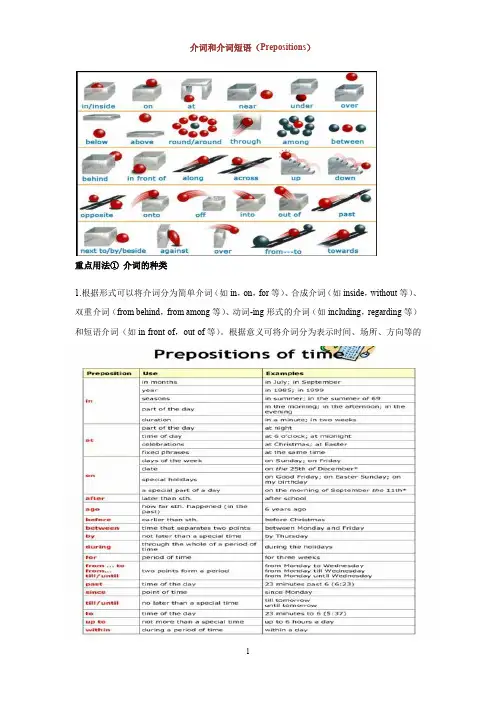
介词和介词短语(Prepositions)重点用法①介词的种类1.根据形式可以将介词分为简单介词(如in,on,for等)、合成介词(如inside,without等)、双重介词(from behind,from among等)、动词-ing形式的介词(如including,regarding等)和短语介词(如in front of,out of等)。
根据意义可将介词分为表示时间、场所、方向等的介词,介词在句中不能独立做成分。
2.表示时间的介词after在……之后before在……之前around大约……at在……时by到……为止in在……后on在……时till/until直到……3.表示场所、方向的介词across在……对面along沿着……at在……in在……里on在……上above在……上方under/below在……下面beside在……旁边behind在……后面before/in front of在……前面between在……之间among在……之间4.其他介词about关于;对于from从;自从with与……一起;用of……的;属于……的to向;到;对as担任;像;作为for对于;为了;给……besides除了……还有重点用法②表示时间的常用介词辨析用法:1.at表示时刻、时间的某一点;on表示具体的某一天,某一天的上、下午;in表示月、季节、年,泛指上午、下午、晚上(在一段时间内)。
at lunch在午餐时on Monday在周一in January在一月2.before表示“在……之前”;after表示“在……之后”。
I will be back before lunch.午饭之前我赶回来。
The nights start after half past five in winter.冬天的夜晚在5点半之后开始。
3.by表示“在……之前,截止到……”;until/till表示“直到……为止”;by表示到什么时候为止动作已经完成,而until表示动作持续到什么时候,在终止性动词的否定式中,二者通用。
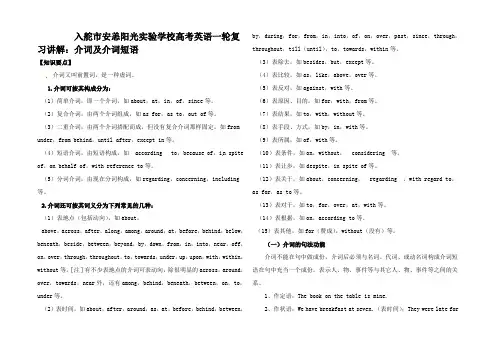
入舵市安恙阳光实验学校高考英语一轮复习讲解:介词及介词短语【知识要点】介词又叫前置词,是一种虚词。
1.介词可按其构成分为:(1)简单介词,即一个介词,如about,at,in,of,since等。
(2)复合介词,由两个介词组成,如as for,as to,out of 等。
(3)二重介词,由两个介词搭配而成,但没有复合介词那样固定,如from under,from behind,until after,except in 等。
(4)短语介词,由短语构成,如according to,because of,in spite of,on behalf of,with reference to 等。
(5)分词介词,由现在分词构成,如regarding,concerning,including 等。
2.介词还可按其词义分为下列常见的几种:(1)表地点(包括动向),如about,above,across,after,along,among,around,at,before,behind,below,beneath,beside,between,beyond,by,down,from,in,into,near,off,on,over,through,throughout,to,towards,under,up,upon,with,within,without等。
[注]有不少表地点的介词可表动向,除很明显的across,around,over,towards,near外,还有among,behind,beneath,between,on,to,under等。
(2)表时间,如about,after,around,as,at,before,behind,between,by,during,for,from,in,into,of,on,over,past,since,through,throughout,till(until),to,towards,within 等。
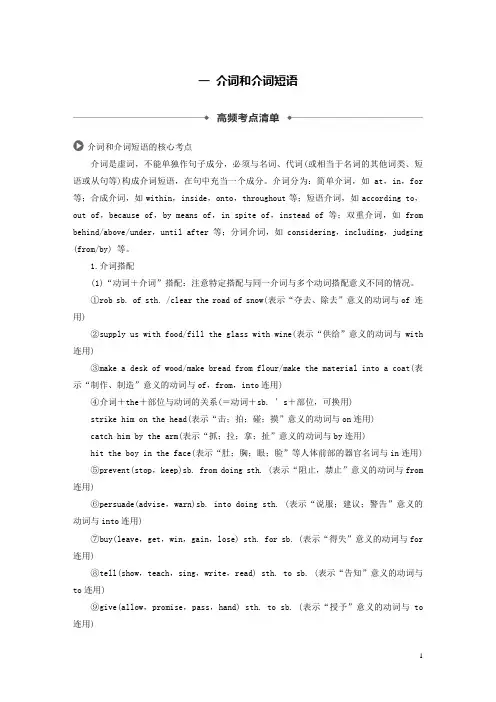
一介词和介词短语介词和介词短语的核心考点介词是虚词,不能单独作句子成分,必须与名词、代词(或相当于名词的其他词类、短语或从句等)构成介词短语,在句中充当一个成分。
介词分为:简单介词,如at,in,for 等;合成介词,如within,inside,onto,throughout等;短语介词,如according to,out of,because of,by means of,in spite of,instead of等;双重介词,如from behind/above/under,until after等;分词介词,如considering,including,judging (from/by) 等。
1.介词搭配(1)“动词+介词”搭配:注意特定搭配与同一介词与多个动词搭配意义不同的情况。
①rob sb. of sth. /clear the road of snow(表示“夺去、除去”意义的动词与of 连用)②supply us with food/fill the glass with wine(表示“供给”意义的动词与with 连用)③make a desk of wood/mak e bread from flour/make the material into a coat(表示“制作、制造”意义的动词与of,from,into连用)④介词+the+部位与动词的关系(=动词+sb. ’s+部位,可换用)strike him on the head(表示“击;拍;碰;摸”意义的动词与on连用)catch him by the arm(表示“抓;拉;拿;扯”意义的动词与by连用)hit the boy in the face(表示“肚;胸;眼;脸”等人体前部的器官名词与in连用)⑤prevent(stop,keep)sb. from doing sth. (表示“阻止,禁止”意义的动词与from 连用)⑥persuade(advise,warn)sb. into doing sth. (表示“说服;建议;警告”意义的动词与into连用)⑦buy(leave,get,win,gain,lose) sth. for sb. (表示“得失”意义的动词与for 连用)⑧tell(show,teach,sing,write,read) sth. to sb. (表示“告知”意义的动词与to连用)⑨give(allow,promise,pass,hand) sth. to sb. (表示“授予”意义的动词与to 连用)注意:⑦⑧⑨可换成buy sb. sth. ,tell sb. sth. ,give sb. sth. 双宾结构。
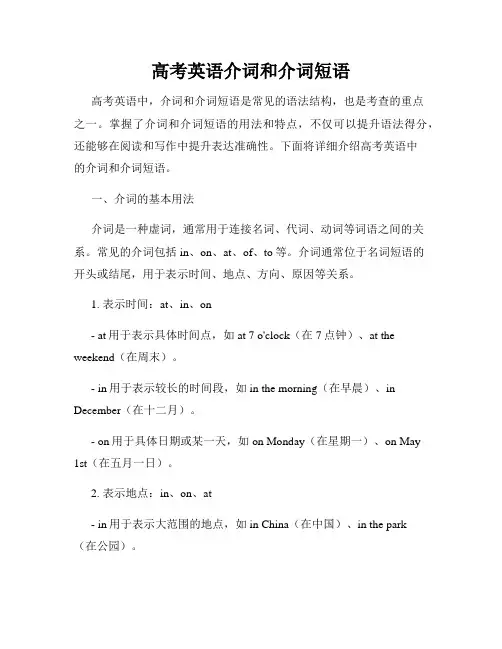
高考英语介词和介词短语高考英语中,介词和介词短语是常见的语法结构,也是考查的重点之一。
掌握了介词和介词短语的用法和特点,不仅可以提升语法得分,还能够在阅读和写作中提升表达准确性。
下面将详细介绍高考英语中的介词和介词短语。
一、介词的基本用法介词是一种虚词,通常用于连接名词、代词、动词等词语之间的关系。
常见的介词包括in、on、at、of、to等。
介词通常位于名词短语的开头或结尾,用于表示时间、地点、方向、原因等关系。
1. 表示时间:at、in、on- at用于表示具体时间点,如at 7 o'clock(在7点钟)、at the weekend(在周末)。
- in用于表示较长的时间段,如in the morning(在早晨)、in December(在十二月)。
- on用于具体日期或某一天,如on Monday(在星期一)、on May1st(在五月一日)。
2. 表示地点:in、on、at- in用于表示大范围的地点,如in China(在中国)、in the park(在公园)。
- on用于表示小范围的地点,如on the table(在桌子上)、on the bus(在公交车上)。
- at用于表示具体点位或某一地点,如at the cinema(在电影院)、at the corner(在拐角处)。
3. 表示方向:to、from- to表示运动的目的地,如go to school(去学校)、travel to Paris (去巴黎)。
- from表示运动的起点,如come from Beijing(来自北京)、fly from London to New York(从伦敦飞往纽约)。
4. 表示原因:because of、due to- because of和due to都可以表示原因,但用法稍有不同。
because of 后接名词或名词短语,due to后接名词或代词。
例如:He failed the exam because of his laziness.(他考试失败是因为他太懒了。


2015高考英语(江西专用)一轮复习语法专项:动词与动词短语考点一与不同介词(副词)搭配的动词1.add短语add to增加,增添add up加起来add up to总计,共达2.break短语break away from脱离break down坏掉;出故障;垮掉break into闯入,破门而入break out(战争)爆发break in破门而入break off打断;中断break through逾越,突破;冲破break up打碎;(物理)分解;分开;结束;制止[考题印证](2013·太原五中9月月考)The lift ________ and we were trapped inside it.A.broke down B.broke upC.broke out D.broke in解析:考查动词短语辨析。
根据后面的we were trapped inside it可知电梯坏了,因此选择broke down。
答案:A3.bring短语bring about导致,引起bring down使倒下;降低(费用,开支,价格等)bring in引进;挣得bring on使发展,有助于生长;引起,导致(疾病,战争等)bring out使展现;阐明;出版bring up养育,培养;呕吐;提出(建议、论点等)[考题印证](2013·云南师大附中月考六)Excuse me, but can you make a sentence to ________ the meaning of the verb phrase?A.bring up B.bring inC.bring about D.bring out解析:考查动词短语辨析。
bring up意为“提出;养育”;bring in意为“引进;生产”;bring about意为“引起”;bring out意为“出版;使显示;说出”。
由语境可知,此处是指“造一个句子来表达这个动词短语的意思”。
■四、介词和介词短语//〃// ///〃/■介词主要考查近义词的用法区别、介词的特定含义、介词和连词易混淆的项目、介词的固定用法等,不仅在单项填空中进行考查,在短文改错题中,对于介词的有无、介词与其他词的固定搭配的考查尤为频繁。
因为介词的用法非常普遍,它关系到句子的上下衔接,所以以后的高考题介词仍然是一个考备热点。
■高考研究介词是英语中比较活跃的词,中学阶段所学的介词有40多个。
它与名词、形容词、副词和动词等构成搭配时用法灵;活,意义丰富。
搭配比较活跃的介词主要;有in, out, up, down, on, off, to, from,for, over, with等。
预测今后高考介词的考查将以介词的固定短语和介词辨析为主O在学习介词时,应重点掌握介词的基本用法,同时注意总结其与名词、形容词、副词、动词等搭配构成的短语的意思和用法。
江苏的高考中通常在单选中、完型中〃〃/7 //////■考点一常用介词的用法■ 1.介词at可表示动作、感情的原因,意思是“因……而;一听到(看到/想到)……就”■ Why was the boy surprised at the writer's request?-那男孩为什么对作者的请求感到吃惊?■2. on +名词或e.ing形式可表示“一...... 就O■On his arrival at the hotel he went straight to the counter and spoke to the clerk in uniform behind it.碁一到饭店,他就径直往柜台走去,并与柜台后边穿制服的店员说话。
■On arriving home, I discovered they had gone・■我一到家就发现他们已经离开了。
3. to 与情感名词连用,表示“ 使人产生的感觉”。
状语,位置前、中后皆可。
为了强调,可在前面加much 。
2015高考英语(江西专用)一轮复习语法专项:介词与介词短语考点一表进行意义的四类介词短语1.at+名词He was at dinner when I came.我来时他正在吃饭。
She stayed at work when everybody else had gone home.别人都回家了,她却还在工作。
类似的还有:at play在玩耍at lunch在吃午饭at rest在休息at table在吃饭at school在上学at church在做礼拜at peace在和平时期at press在排印有些结构可能带有冠词或物主代词:at one's meals在吃饭at one's study在学习at the piano在弹钢琴at the end of...在……结束时[考题印证](2012·全国Ⅱ)100℃ is the temperature ________which water will boil.A.for B.atC.on D.of解析:由于本句中的which指代上文的100℃,表示“在多少度”应用介词at。
故选B项。
答案:B2.in+名词He's been in politics all his life.他一生从政。
Her husband was in business.她丈夫是经商的。
He looks tired.He is in need of a rest.他看起来累了,需要休息一下。
类似的还有:in action在运转in progress在进行中in operation在运行中有些结构可能带有冠词:in the course of...在……过程中in the act of...正在做……时[考题印证](2011·北京)With new technology, pictures of underwater valleys can be taken ________ color. A.by B.forC.with D.in解析:by“通过……”,表示方式、手段;for“为了”,表示目的;with“和……”,表示状态;in“以……,用……”,表示所用的原料、材料,i n color“用彩色,以彩色”。
句意:有了新的技术,水下山谷的照片可以照成彩色的。
答案:D3.on+名词Are you here on business or for pleasure?你是来办事还是来玩?The typist is away on holiday this week.打字员本周去休假了。
The man on watch didn't notice the danger.值班的人没有注意到这危险。
类似的还有:on guard在执勤on leave在休假on strike在罢工on sale出售on loan(画或书等)暂借(的)有些结构可能带有冠词:on the march在行军on the watch注意,提防on the increase正在增加on the go十分活跃;非常忙碌on (the)air正在广播[考题印证](2011·四川)Nick, it's good for you to read some books ________ China before you start your trip there. A.in B.forC.of D.on解析:on在此表示“关于”。
句意:尼克,在你去中国旅游前,看看有关中国的书对你有好处。
答案:D4.under+名词(名词前有时有冠词修饰)Don't worry.Everything is under control.别担心,一切都在控制之中。
That has no relation to the matter under discussion.那和讨论的问题没有关系。
类似的还有:under development在发展中under observation在观察中under test在被测试under construction在建设中under fire在炮火中under examination在检查(调查)中under consideration在考虑中under repair在修理中[考题印证]It is said children ________ six years old are admitted free.A.of B.withC.under D.over解析:句意:6岁以下的儿童免费进入。
答案:C考点二几个易混介词的区别1.at,in,on表示地点at指较小的地方,用于门牌号码前。
in一般指较大的地方。
商店、学校、机关等,若看作一个地点,或一个场所,虽然小,如果说话人住在那里,也可以用。
如:He was standing at the door.他正站在门边。
I work in the shop.我在商店上班。
on表示地点,一般指与面或线接触,意为“在……上,在……旁”。
如:The picture is hanging on the wall.这张画挂在墙上。
Nanjing is on the Changjiang River.南京在长江边上。
2.in,to,on用在方位名词前in表示在范围之内的地方to表示在范围之外的地方on表示两地接壤Shanghai lies in the east of China and to the north of Guangdong.上海位于中国东部,广东北部。
[考题印证](2012·北京重点高中尖子生综合素质展示)Living with cancer has made her realize how important it is to take every chance to live her life ________ the fullest.A.at B.onC.to D.with解析:句意:身患痛症让她意识到利用每一次机会把人生过得最充实是多么重要。
to the fullest 表示;“最充分地”,是固定结构。
答案:C3.near,by,beside表示“在附近”near表示相对的“近”,实际距离可能还很远。
如:The small child was afraid to go near the dog.那小孩子不敢靠近那条狗。
by和beside都表示“靠近”,实际距离可能不是很远,beside比by更具体表示“在……旁边”。
如:She was standing beside her mother.她正站在她母亲旁边。
Come here and get warm by the fire.过来,烤火暖和一下。
4.from,out of表来源二者均表示来源或出处。
from注重起点,意为“从……”;out of侧重于从里向外,意为“从……里出来”。
如:The shouting of the soldiers' drilling could be heard from the playground.从操场上传来了士兵训练的呐喊声。
She took the passport out of her handbag and showed it to the policeman.她从手提包里拿出了护照并把它出示给警察看。
5.by,in,on三词都表示旅行的方式(1)by用在不涉及交通工具的名词前时,其前不带冠词。
如:by sea,by air,by water,by land,by rail等。
(2)by用在涉及交通工具的名词前时,此名词须用单数,其前面不加冠词或修饰语。
如:by bike,by taxi,by plane,by ship/boat,by train,by spaceship等。
(3)当旅行方式涉及确定特指的交通工具时,用on或in,名词前用冠词、物主代词、指示代词等修饰语。
如:travel to New York in this plane, leave on an early train, go to school on my bike等。
说明:步行、骑马用on。
如:on foot,on horseback,on a horse等。
6.with,by,in三词均译为“用”,表示行为的工具、手段或方式(1)with用于有形的工具或身体某器官之前,其后的名词多被冠词、物主代词等修饰。
如:They are digging with spade.他们在用铁锹挖地。
We see with our eyes, hear with our ears, and walk with our legs.我们用眼睛看东西,用耳朵听事,用腿走路。
(2)by,in,on,over,through等多用于无形的工具或方式手段之前。
如:by hand,in ink,on the telephone,over the radio,through the telescope等。
You can order tickets by telephone.你可以用电话订票。
说明:①使用语言、原料、材料时用in表示。
如:in English/Japanese,in blue ink等。
②表达“用……方法/式”时,所用介词分别为:in this/that/the same wayby means ofby this/that meanswith this/that method[考题印证]①(2012·北京)Do you think this shirt is too tight ______ the shoulders?A.at B.onC.to D.across解析:由“the shoulders”可以看出是指表面上双肩之间的距离,所以用across。
故选D。
答案:D②—How can I reserve the tickets?—________ phone.A.On B.With C.By D.In解析:by phone意思是“通过电话”,即通过电话订票。
答案:C考点三介词(短语)的固定搭配1.for与of表示不定式复合结构的逻辑主语(1)It is+adj.+of sb.to do sth.=Sb.+be+adj.+to do sth.当形容词是表示人的属性的词汇时,用of。
常见的形容词有kind,good,nice,clever,stupid,foolish,considerate,polite,impolite,cruel等。
如:It is kind of them to help support the poor students.=They are kind to help support the poor students.他们帮助抚养贫困生真是太好了。